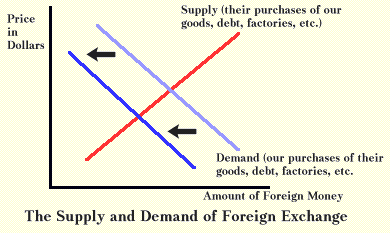The foreign exchange market provides an excellent illustration of how financial markets can transmit disturbances. The market is usually considered to be an efficient market, not subject to runaway speculative binges. The heart of the market is the trading by a number of very large banks. A trade worth a million dollars is very small in this market, but it is the prices of these very large bank transactions that newspapers report when they publish exchange rates. When you deal in smaller amounts when you travel to Thailand, you will get less favorable prices.
The market for foreign exchange can be analyzed in terms of supply and demand. Americans demand foreign money (and supply dollars) when they buy things abroad, such as vacations, goods, services, factories, and financial assets. Foreigners supply foreign currency (and demand dollars) when they buy things here, such as vacations, goods, services, factories, and financial assets. Although when you buy a Japanese camera, you do not deal in the foreign exchange market, someone did in the process of bringing the camera to you. It may have been the American importer, who would have sold dollars to buy yen, and then used the yen to buy the camera. Or it may have been the Japanese exporter, who sold cameras for dollars and then sold the dollars for yen. In either case, dollars were supplied to the foreign exchange market and yen were demanded.
The exchange rate, or the price of foreign money, is an important price when we buy things made in other countries. For example, the manufacturer of the camera in the previous paragraph paid its workers in yen. The camera has a yen price. Suppose the price of the camera in yen is 50,000 yen. How much will this camera cost in terms of dollars? To determine this, we must know the value of yen in terms of dollars, or the exchange rate. Suppose one dollar is worth 250 yen. Then to find the value of the camera in dollars, we can use this equation:
(1) Dollar price = exchange rate x yen price
or:
(2) Dollar price = (number of dollars/number of yen) x yen price.
Substituting the values we have we find:
(3) Dollar price = ($1/(250 yen)) x (50,000 yen/(1 camera))
Canceling out where we can gives us:
(4) Dollar price = $200/1 camera.
Two things affect the price of the Japanese camera as seen from America. The first is the yen price of the camera, and the second is the dollar price of the yen. If either one increases, Japanese cameras will become more expensive, and Americans will want fewer of them. The exchange rate also affects the price of American goods as seen in Japan. One can use the same equation to compute what the yen price of a bushel of soybeans will be if the dollar value is $10. Substituting into equation 2 we get:
(5) $10/1 bushel of soybeans = ($1/250 yen) x yen price.
Ninth grade algebra tells us to divide through by the exchange rate to get the equation into the form:
(6) ($10/1 bushel of soybeans) x (250 yen/$1) = yen price.
Solving gives us
(7) 2500 yen/1 bushel = yen price,
or that a bushel of soybeans will cost 2500 yen.
The graph below shows a supply and demand graph for foreign exchange. When foreign currency is cheap, foreign products are cheap in dollars and Americans will want a lot of them. To buy these foreign products, Americans must buy a lot of foreign exchange. When the price of foreign exchange is expensive, so too will be foreign products, and Americans will not want many. Hence, they will not need as much foreign exchange. Thus, the demand for foreign exchange will have the negative slope that demand curves are supposed to have. Unfortunately, we cannot show that the supply curve has a positive slope with this reasoning, (there is no law of supply), but a positive slope is not unreasonable.1
Supply and Demand of Foreign Exchange

Let us consider what will happen if the United States increased its tariffs. Because tariffs are taxes on imports, foreign products will become more expensive for Americans. As a result, Americans will want to buy fewer imports, which is usually the desired result of tariffs. However, if the exchange rate is a floating rate, that is, one that can take whatever value supply and demand dictate, the story has not ended. As a result of the tariff and the resulting decrease in imports, the demand curve for foreign exchange shifts to the left. As a result, foreign money becomes cheaper for Americans and American dollars become more expensive for foreigners. If dollars become more expensive, foreigners will find American goods more expensive. (You can check this by seeing what the yen price of soybeans becomes if the dollar rises in value so that it is worth 300 yen.) As dollars become more expensive, foreigners will reduce the amounts that they buy from us. The end effect of a tariff with floating exchange rates, then, is to cut not just imports, but to cut exports as well. This latter effect is a totally unintended consequence but one that illustrates how financial markets can transmit effects from one place to another.
We finish with an alternative to floating rates.



No hay comentarios:
Publicar un comentario